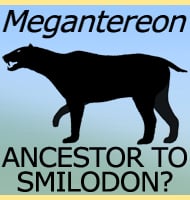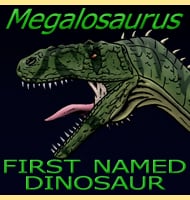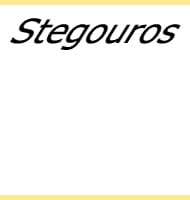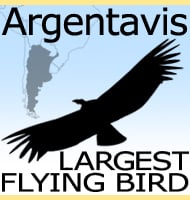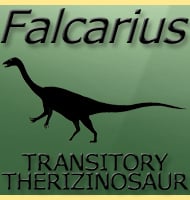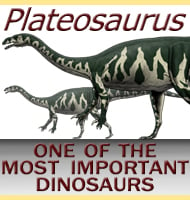In Depth
Remarkably when Troodon was first ‘discovered’ it was only known from a tooth, and it was the description of this tooth that gave rise to the genus.
Although naming a creature after only discovering its teeth is hard to imagine today, it was a common place practice in the nineteenth century, and at least in the case of Troodon the teeth were different to most others.
Two problems arose from describing Troodon from only teeth. One, while these teeth were curved like in a carnivore, they had curved serrations similar to some herbivores.
Two, because no one knew of any skeletal remains, no one knew what kind of dinosaur it actually was, or even if it really was a dinosaur for that matter.
When named by Joseph Leidy in 1856, Troodon was classed as a lizard.
When classed as a dinosaur in 1901, Troodon was assigned to the megalosauridae, a wastebasket group at the time that was used as a dumping ground for any carnivorous dinosaur whose kind and position among others was not known.
In 1924 Troodon ‘became’ a pachycephalosaur, a herbivorous kind of dinosaur known for having dome headed skulls, with the grouping made on the basis of similarities between their teeth, notably the serrations.
It should also be mentioned that as Troodon was grouped with them, all pachycephalosaurs known at the time were classed under Troodontidae, until 1945 when Troodon was removed from the group on the basis that its teeth were for a carnivorous purpose.
Because the group could not be called after a dinosaur that was no longer a part of it, they were re-named the pachycephalosuars after Pachycephalosaurus.
Skipping back to 1932, and another genus of dinosaur, Stenonychosaurus, was formally described to science.
This was a small predator, later realised to have had teeth similar to Troodon.
But for over fifty years Stenonychosaurus and Troodon were kept separate, until 1987, when palaeontologist Philip J. Currie found Stenonychosaurus to be a synonym of Troodon.
This was done on the basis that differences in tooth and jaw form of known troodonts seemed to have been down to age and growth and were probably representing a single species of dinosaur.
The addition of this fossil material to Troodon allowed the first accurate reconstructions of the genus.
As a small predator with a sickle shaped claw on each foot, Troodon was often recreated in popular science, as a small but fierce and deadly predator that terrorised Late Cretaceous North America.
This depiction was common throughout the late twentieth/early twenty-first centuries.
Now it seems things were not so clear cut, and questions over assigning all of this fossil material to Troodon began to be asked as to whether this was the correct thing to do.
This questioning was not just done by some other palaeontologists, but by Philip Currie himself.
Throughout the 1990s and opening years of the twenty-first century new ideas that fossils from different formations could represents at least different species of Troodon, perhaps even different genera of troodontid dinosaurs, were often discussed.
Ultimately the problem of Troodon always came down to the same issue.
Troodon was established upon the basis of teeth, and like all creatures described by only teeth, it is almost impossible to refer fossils on bone material.
On the principal of extra fossil bones later assigned to Troodon, there was just not a clear example to prove a connection, just superficial similarity.
Thirty years after Troodon and Stenonychosaurus were synonymised together, they were split again in 2017.
Fossils of bones once used to reconstruct Troodon now either placed back into the resurrected Stenonychosaurus genus, or moved into an additional new genus called Latenivenatrix.
This conclusion is the culmination of work by many palaeontologists again including Philip Currie.
While some palaeontologists have not been quick to accept the removal of bone fossils from Troodon, at the time of writing (2020) most palaeontologists are working with the resurrection of Stenonychosaurus and description of Latenivenatrix as valid.
With Troodon being dubbed a ‘tooth taxon’ (known only from teeth), Troodon itself is now once again regarded as a dubious genus of dinosaur.
Further Reading
- - Notices of remains of extinct reptiles and fishes, discovered by Dr. F. V. Hayden in the bad lands of the Judith River, Nebraska Territory. - Proceedings of the Academy of Natural Sciences of Philadelphia 8:72-73. - J. Leidy - 1856.
- - The dentary of Troödon, a genus of theropod dinosaurs. - Journal of Paleontology 22(5):625-629. - L. S. Russel - 1948.
- - A new specimen of Stenonychosaurus from the Oldman Formation (Cretaceous) of Alberta. - Canadian Journal of Earth Sciences 6:595-612. - D. A. Russel - 1969.
- - Reconstruction of the small Cretaceous theropod Stenonychosaurus inequalis and a hypothetical dinosauroid. - Syllogeus 37: 1–43. - D. A. Russel & R. Séguin - 1982.
- - Theropods of the Judith River Formation of Dinosaur Provincial Park, Alberta, Canada, by P. J. Currie. - In Fourth Symposium on Mesozoic Terrestrial Ecosystems. Tyrrell Museum of Paleontology, Drumheller, Alberta 52-60. - P. J. Currie & E. H. Koster (eds.) - 1987.
- - Bird-like characteristics of the jaws and teeth of troodontid theropods (Dinosauria, Saurischia). - Journal of Vertebrate Paleontology 7: 72–81. - P. J. Currie - 1987.
- - Bone microstructure of the Upper Cretaceous theropod dinosaur Troodon formosus. - Journal of Vertebrate Paleontology 13, 99-104. - D. V. Varricchio - 1993.
- - Denticle Morphometrics and a Possibly Omnivorous Feeding Habit for the Theropod Dinosaur Troodon. - Gaia 15. - Thomas R. Holtz, Daniel L. Brinkman & Christine L. Chandler - 1998.
- - Embryos and eggs for the Cretaceous theropod dinosaur Troodon formosus. - Journal of Vertebrate Paleontology 22 (3): 564–576. - David J. Varricchio, John R. Horner & Frankie D. Jackson - 2002.
- - The last polar dinosaurs: high diversity of latest Cretaceous arctic dinosaurs in Russia. - Naturwissenschaften - P. Godefroit, L. Golovneva, S. Shchepetov, G. Garcia & P. Alekseev - 2008.
- - On the Occurrence of Exceptionally Large Teeth of Troodon (Dinosauria: Saurischia) from the Late Cretaceous of Northern Alaska. - Palaios volume 23 pp.322-328. - Anthony R. Fiorillo - 2008.
- - Description of two partial Troodon braincases from the Prince Creek Formation (Upper Cretaceous), North Slope Alaska. - Journal of Vertebrate Paleontology 29(1):178-187. - A. R. Fiorillo, R. S. Tykoski, P. J. Currie, P. J. McCarthy & P. Flaig - 2009.
- -A new species of troodontid theropod (Dinosauria: Maniraptora) from the Horseshoe Canyon Formation (Maastrichtian) of Alberta, Canada. Canadian Journal of Earth Sciences. 54 (8): 813–826. - D. C. Evans, T. M. Cullen, D. W. Larson & A. Rego - 2017.
- - Troodontids (Theropoda) from the Dinosaur Park Formation, Alberta, with a description of a unique new taxon: implications for deinonychosaur diversity in North America . Canadian Journal of Earth Sciences 54:919-935. - A. J. van der Reest & P. J. Currie - 2017.



